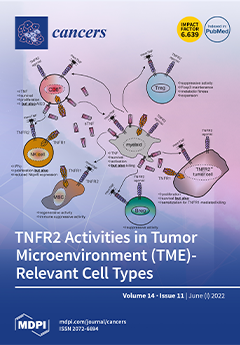Background: Long non-coding RNAs (lncRNAs) play an important role in cellular activities and functions, but our understanding of their involvement in cancer is limited.
Methods: TCGA data on RNA expression and DNA methylation were analyzed for lncRNAs’ association with breast cancer survival, using
[...] Read more.
Background: Long non-coding RNAs (lncRNAs) play an important role in cellular activities and functions, but our understanding of their involvement in cancer is limited.
Methods: TCGA data on RNA expression and DNA methylation were analyzed for lncRNAs’ association with breast cancer survival, using the Cox proportional hazard regression model. Fresh tumor samples and clinical information from 361 breast cancer patients in our study were used to confirm the TCGA finding on
ZNF582-AS1. A RT-qPCR method was developed to measure
ZNF582-AS1 expression. Survival associations with
ZNF582-AS1 were verified with a meta-analysis.
In silico predictions of molecular targets and cellular functions of
ZNF582-AS1 were performed based on its molecular signatures and nucleotide sequences.
Results:ZNF582-AS1 expression was lower in breast tumors than adjacent normal tissues. Low
ZNF582-AS1 was associated with high-grade or ER-negative tumors. Patients with high
ZNF582-AS1 had a lower risk of relapse and death. These survival associations were confirmed in a meta-analysis and remained significant after adjustment for tumor grade, disease stage, patient age, and hormone receptor status. Correlation analysis indicated the possible suppression of
ZNF582-AS1 expression by promoter methylation. Bioinformatics interrogation of molecular signatures suggested that
ZNF582-AS1 could suppress tumor cell proliferation via downregulating the HER2-mediated signaling pathway. Analysis of online data also suggested that HIF-1-related transcription factors could suppress
ZNF582-AS1 expression, and the lncRNA might bind to hsa-miR-940, a known oncogenic miRNA in breast cancer.
Conclusions: ZNF582-AS1 may play a role in suppressing breast cancer progression. Elucidating the lncRNA’s function and regulation may improve our understanding of the disease.
Full article






